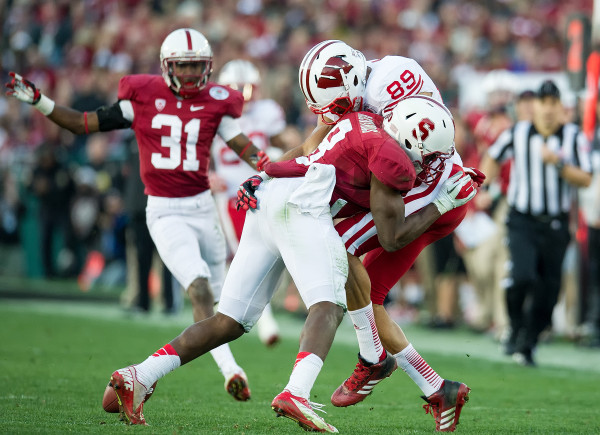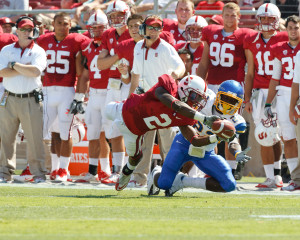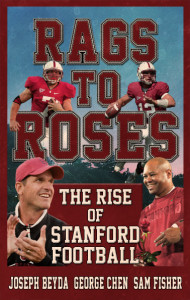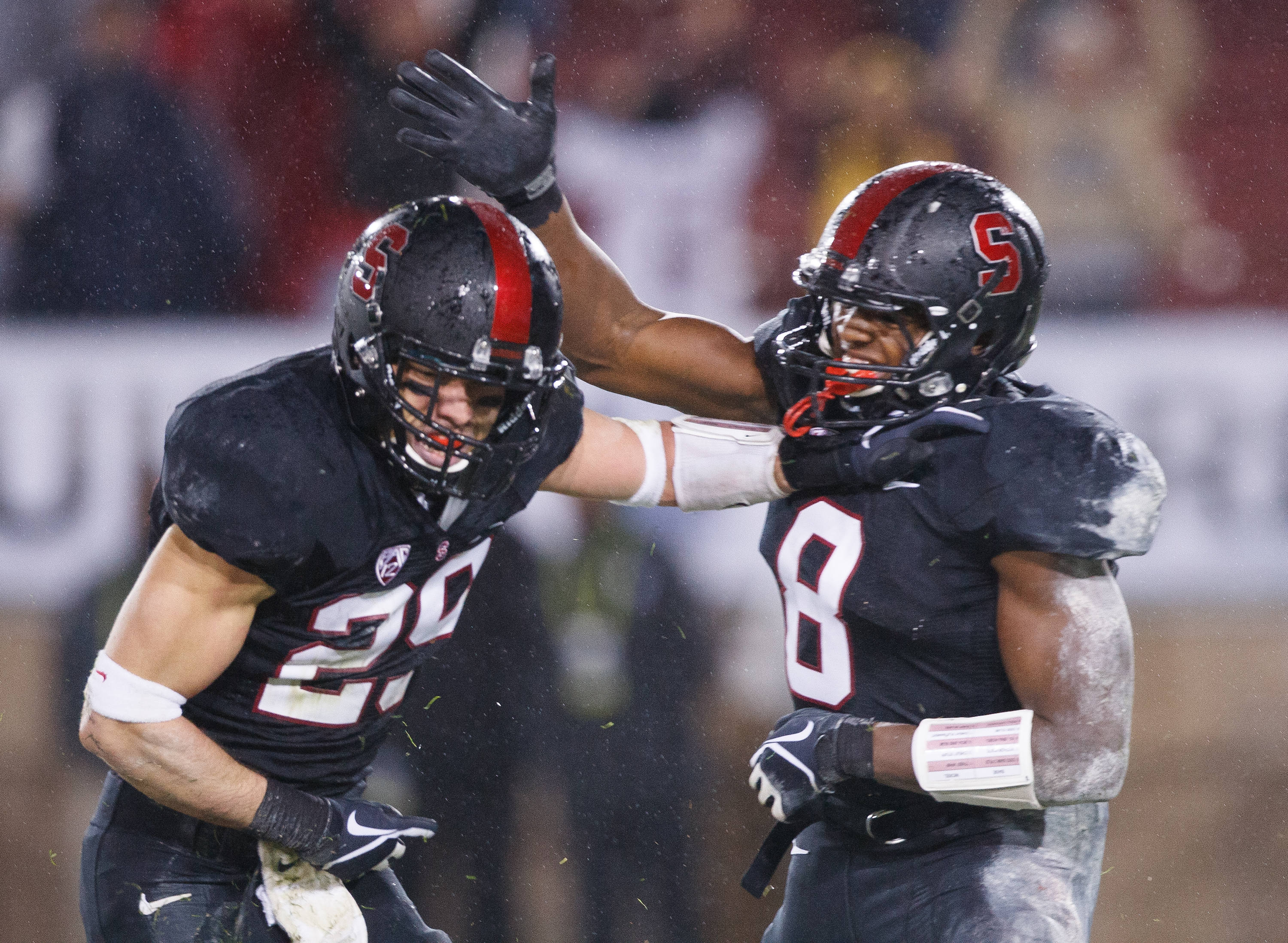The defensive slugfest has reached its peak in the third quarter of the 2013 Rose Bowl Game.
Facing a second-and-7 near midfield, Wisconsin quarterback Curt Phillips drops back to pass after a play-action fake to halfback stud Montee Ball. Phillips sees an open wide receiver, Chase Hammond, sneaking down the left sideline, and launches the ball in his direction.
Hammond leaps into the air and grabs the ball, but before he can come back down to the ground, a Stanford safety comes in to lower the boom. The timing is impeccable. The defender delivers a bone-crunching — and more importantly, clean — hit and the ball is violently knocked loose, resulting in an incompletion.
The Cardinal safety who made the big play isn’t Ed Reynolds, the well-known ball hawk who has dazzled Stanford fans with pick-sixes throughout the season. Instead, it’s his overshadowed partner-in-crime, strong safety Jordan Richards.

In 2012, the electric Reynolds received much of the spotlight in the Cardinal secondary — rightfully so, considering he singlehandedly turned the tide in the Pac-12 Championship Game and was just one blown call away from breaking the NCAA records for interception return touchdowns and yardage. Had it not been for Reynolds’ momentum-shifting interception, Stanford might have found itself playing in San Antonio instead of Pasadena.
But while Reynolds was raising eyebrows with his knack for terrorizing opposing quarterbacks, Richards was quietly having one of the most productive seasons for a Cardinal defensive back in recent memory. The 5-foot-11, 208-pound safety led the team with 12 pass breakups, came in second with three interceptions and finished third with 68.0 total tackles. Even in the Pac-12 Championship Game in which Reynolds shined, Richards notched a career-high 11 tackles, including one tackle for loss.
Head coach David Shaw often talks about the critical time when “the light comes on” for a developing player, both mentally and physically. For Richards, that moment came during spring ball after his freshman year, a season in which he saw significant action and made three starts when former Stanford safety Delano Howell went down with an injury.
“You sit down and you see what you did on film as a true freshman, and I put some bad things on film,” Richards said. “Just getting to watch that again and going through a whole another spring of installs, the light does come on. And you realize it’s not as hard as you think it is if you just talk and communicate with the other 10 guys on the field.”
The proverbial light came on even quicker for cornerback Alex Carter, the only true freshman starter on the team in 2012. When Carter arrived on the Farm, he had all the physical tools he needed to succeed: His vertical jump was 40 inches, his broad jump was around 10 feet and his 40-yard time was in the 4.4 range. It was only a matter of time before the freshman proved he could translate those raw talents into on-field success. After playing on special teams — including handling kickoff return duties — during the early part of the season, Carter won the starting corner job over his teammate Barry Browning midway through the year.
Carter quickly became known for his physicality, a trait that allowed him to jam opposing receivers at the line of scrimmage. Even when a receiver caught the ball, Carter made sure to make his opponent paid the price with a big hit; in fact, he led the Cardinal with three forced fumbles last season.
“Just being part of the defense forced me to be [physical],” Carter said. “You have guys like Shayne Skov, AJ Tarpley and Ben Gardner. They’re all just physical guys and to be a part of this defense, I had to be physical as well.”
The freshman also made good use of his speed last season, and it especially came in handy against the run. The Oregon game served as a perfect example, as Carter’s quickness played a crucial role in containing the explosive Ducks running backs on the outside. Once the Cardinal defensive linemen and linebackers got penetration, Oregon often failed to stretch the field horizontally simply because Carter’s speed did not allow any player to run by him.

On the other side of the field, junior Wayne Lyons will take over at corner for Terrence Brown, who signed with the Cincinnati Bengals in April. Lyons played in the first two games of his freshman season before missing the remainder of 2011 with a broken foot, and then saw playing time in all 14 games in 2012. The Florida native already has some big plays under his belt; during the fourth quarter of last year’s Big Game, he made his first career interception. But he hasn’t necessarily achieved the potential he exhibited back in 2011 — until now.
“[Lyons is] playing some of his best football right now,” said defensive coordinator Derek Mason. “He’s made very few mental [mistakes]. A lot of good decisions and he’s tackling well. It’s what we sort of expected from Wayne coming in a couple years ago.”
After being maligned for its inconsistent play in 2011, Stanford’s secondary re-gained its prowess by more than doubling its interception total (15) and also cutting down the number of passing touchdowns it allowed (13). And with the exception of Brown, every defensive back, including Browning, Usua Amanam, Devon Carrington, Ronnie Harris and Zach Hoffpauir, who saw significant game action in 2012 has returned. Against the numerous spread offenses that the Cardinal expects to face this season, that depth and even greater improvement in the secondary will be key.
“As a group last year, we definitely took strides in the right direction,” Reynolds said, “when it came to tackling, communication, alignment, assignment…As a unit, we definitely have grown throughout the spring and now, we’re at a good place, but we’re not complacent.”
Communication is critical for a group that’s responsible for defending all of the open space in between the line of scrimmage and the end zone.
“People think everything happens during the play,” Richards said. “But at lining and assigning, getting those adjustments right the first time before the snap happens is so important. That’s what coach Mason and the rest of the DBs focus on, between me and the other guys who are playing back there — we do a good job of that.”
For the Cardinal secondary, the whole is greater than the sum of its parts, but there’s also no question that fans are eager to see if Reynolds can top his three pick-sixes and 301 interception return yards from last season. So, what can they expect?
“Only time will tell,” Reynolds said. “My goal for the year is to have more than last year.”
Contact George Chen at gchen15 “at” stanford.edu.
Previous installments in our 2013 football season preview:
Aug. 28: Young Stanford receivers look to end two years of mediocrity
Aug. 26: Without Taylor, the Cardinal stable re-opens
Aug. 25: Anderson, Stanford defensive line look to wreak havoc once again
Aug. 20: Tarpley, Skov and Murphy headline Stanford’s elite linebacker corps
Aug. 19: Upstart tight ends look to fill void left by Ertz, Toilolo
Aug. 14: Hogan embraces leadership role, ready to take the next step
Aug. 13: Offensive line powers forward, seeks new center

